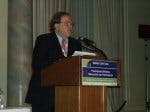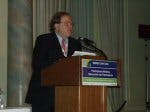I am writing this article to provide some balance and perspective as to the positive effects and the real potential value of Energy Star. It is difficult to be objective when one sees so much going wrong in the US SSL criteria conflict (see Energy Star Wars and the battle to label LED fixtures). As an avid participant of Energy Star, as both my company, FIRSTeam – LEDesignWorks, and our energy efficiency organization, greenTbiz, are both registered Canadian participants as well as being an active proponent and supporter, I can truly see the value of the brand. Ironically, myself and other participants learned about the US situation while attending the Canada event described below. With this in mind, it is hoped that the following will highlight the true intent, meaning, objectives and value of such an important icon in energy efficiency, both in Canada and the United States. Although it is impossible to offset the potential damage when something as serious as the EPA issue occurs, one can clearly see the benefits of the program when managed with care and integrity.
Clean Air and a Bright Star
Recently, Energy Star participants from across Canada gathered together in Ottawa, ON for the two-day annual Participants Meeting at the historical and prestigious Chateau Laurier Hotel.John Cockburn, from NRCan’s Office of Energy Efficiency (OEE) opened the program and introduced Carol Buckley, Director General of the OEE. Buckley presented some very interesting statistics from a recent public survey, such as 57% of Canadians are aware of Energy Star in some manner and the younger the respondent, the greater the awareness. The survey indicated high level of loyalty towards Energy Star, as 70% of those asked looked for the Energy Star label when making buying decisions.
Buckley discussed the relationship between loyalty and brand equity, stating the importance of managing and protecting the brand, as well as the importance of strengthening the qualification requirements as technologies become more efficient. The history of Canada’s role was explained as NRCan negotiated an administrative relationship with the US Environmental Protection Agency (EPA) to deliver the Energy Star program in Canada. It was further explained that the intention is to have harmonized standards with the US and work together to develop new and more stringent criteria.
As there was no meeting in 2007, the NRCan OEE team presented two years in review and what’s ahead, including program updates and future directions, update on specifications and regulations, a US Energy Star Program Update and future directions.
Brand News
Anne Wilkins, also with NRCan’s OEE, gave an excellent program overview, highlighting the available resources from the OEE, such as the Energy Star calculator, assistance in procurement, workshops and Energy Star in the news, employing common messaging that can be identified by the consumer or end-user. Wilkins also spoke in depth on managing the Energy Star brand to protect its importance to and integrity with the consumer and end-user. Consistent communications create a brand awareness and understanding. The brand and process must create differentiation while showing relevance. Credibility and satisfaction are important and must be maintained, all leading to the resulting outcome being loyalty due to consumer confidence, which is very important in continuing to build and deliver the brand.
RLF 4.2 – The Canadian View!
In light of the recent developments in US Energy Star for SSL, the toughest presentation belonged to Pierrette LeBlanc, also from NRCan’s OEE. As details of the US debacle were just emerging, most attendees were not aware of the issue.
LeBlanc presented the recent EPA release of Energy Star Program Requirements for Residential Light Fixtures (RLF), Eligibility Criteria – Version 4.2, in which she explained that fixtures using LED light engines can now qualify as Energy Star, however recessed cans are not eligible. The LED light engine efficacy must be 50 lm/W for uncovered light engines and 40 lm/W for covered light engines. She covered criteria for driver temperature and lumen maintenance, such as the L70 for indoor light engines the must equal or exceed 25,000 hours and for outdoor light engines this must be equal to or greater than 35,000 hours. The power factor must be equal to or greater than 0.7.
Following the presentation, I discussed the DOE and EPA situation regarding 4.2 with Pierrette LeBlanc. It was generally expressed that further comprehensive review would be required to determine which criteria would be adopted in Canada. The other question that lies ahead is that, since 4.2 refers to other technology as well as LEDs, how can one adopt 4.2 exclusive of the LED criteria in favour of supporting the stronger DOE criteria?
Please Do NOT Standby
Katherine Delves of NRCan’s OEE introduced Bruce Strathearn from the same office who gave an interesting presentation on standby power. Strathearn presented statistics from a survey of 2200 homes, which showed that Canadians know about the issue, although there is a concern over alternate terminology.
Strathearn commented, “Electricity used in standby power is not ‘wasted’ – it is the price we pay for the added convenience.” He also remarked, “The issue is not that standby (power) exists, nor the functionality that it provides to consumers…[the issue is that] power levels in some products are unacceptable.” In short, for what advantage or reason and at what limit? It is understood that certain internal control technology will require the use of power, but above and beyond the one-watt criteria, manufacturers will have to rethink their design.
For more on standby power, see the end of this article.
Peer Energy
Alex Laskey of Arlington, Virginia (US)-based Positive Energy enlightened the attendees with a presentation on Behavioural Change, mainly directed to utilities, delivering the message to turn bill payers into customers. He discussed how to achieve measurable behavioural savings and increase program participation through one-to-one communications. One major point that he stressed was to use the customers themselves to affect change with adjoining customers in their neighbourhoods through providing neighbourhood consumption data and resultant conservation ‘evangelism’.
[This positive ‘peer pressure’ is no stranger to our greenTbiz program, as our Smart Mentor program establishes peer assistance and recognition, as well as peer ‘evangelism’ and influence.]
Canada’s Energy Stars
Each year, participants are nominated for the annual Market Transformation Awards, which this year recognized two initiatives employing LED technology in Christmas lights, also referred to as holiday or seasonal lights, more specifically SLEDs or Seasonal Light Emitting Diodes. In the Energy Star criteria released in September 2007, the term SLEDs was replaced with DLS or Decorative Light Strings, being technology neutral and non-prescriptive.
Presented by David Anderson, MP and Parliamentary Secretary to the Honourable Gary Lunn, Minister of Natural Resources, the first award went to BC Hydro for their efforts in putting seasonal LED light strings on the map in Canada and for BC Hydro’s market transformation work, retail outlets are bringing seasonal LEDs to more Canadian markets than ever before.
The second award went to the Ontario Power Authority (OPA) for the inclusion of SLEDs in their Every Kilowatt Counts (EKC) coupon rebate program. The award recognized that the OPA EKC program helped make products, such as Energy Star-qualified compact fluorescent light (CFL) bulbs and SLEDs into mainstream products of choice.
Our article LED holiday lighting in Toronto: the Gateway to a Green Way describes some of the developments in holiday lighting in Ontario.
Phil Jessup of the Toronto Atmospheric Fund described Toronto’s LightSavers program, which will aid in accelerating the employment of LED and adaptive lighting control system technologies in public space lighting. Recently launched at LEDiscovery, organized by greenTbiz and reported in LEDs Magazine, LightSavers will bring together both manufacturers and municipalities to pilot technology in various applications, resulting best practices through lessons learned. The LightSavers program receives support from the Office of Energy Efficiency of NRCan and the Technology Development Fund of the Ontario Power Authority.
Chloé Legris of Quebec’s ASTROLab described the development and implementation of their Dark Sky project through extensive community involvement. Dark Sky promotes the use of effectively designed full cut-off luminaires that prevent sky glow and resultant light pollution. Many SSL outdoor luminaire manufacturers are recognizing the importance of Dark Sky-compliant luminaire design, as the directional properties of LED compliment this when factored into the design.
Following the Participants Meeting, NRCan hosted the semi-annual Canadian Lighting Industry Collaborative (CLIC) meeting, a forum for lighting industry personnel, governments, utilities and energy efficiency organizations to discuss issues affecting the forward development and progress of lighting in Canada. At the meeting, LED was on the agenda, when discussing future projects for consideration by NRCan, including consumer awareness and education, demonstration pilots and the development of consumer purchasing information and a municipal procurement guide.
In conclusion, it may be that ‘cooler’ heads will prevail north of the debacle in Washington, but ultimately the end result will affect all. The value of Energy Star is immense and is recognized on both sides of the border, but we have to always remember to whom and that is the customer or end-user. Together we have to have the energy to let the star shine and not let them down!
Notes on Standby Power
The website of the Conservation Bureau of the Ontario Power Authority states, “One of the fastest growing sources of electricity consumption is from standby power losses from consumer and business appliances that are not being used. Any appliance with a clock, an external power supply, or that responds to a remote control draws standby power. Commercial and institutional standby power consumption is estimated to be more than twice as large as residential consumption.”
According to the Lawrence Berkeley National Laboratory (LBNL) website, "Alan Meier, a staff scientist at the LBNL in Berkeley, noted that many household appliances are never fully switched off, but spend most of the time in a standby mode. His 1998 study estimated that standby power consumption accounted for approximately 5% of total residential electricity consumption in America, “adding up to more than $3 billion in annual energy costs”. The wasted energy, in other words, is equivalent to the output of 18 typical power stations.
A similar study in France in 2000 found that standby power accounted for 7% of total residential consumption. In Australia, Germany, Japan and the Netherlands, standby power comprises 10 to 15 percent of total residential electricity use."
A chart depicting 'Estimates of Global Standby Use' can be viewed on the Lawrence Berkeley National Laboratory website at http://standby.lbl.gov/data/International.html.
The website asks, "Is standby power use necessary?" and responds, "Although appliances require some electricity for standby functions, most standby power is consumed by inefficient power supplies and unnecessarily energized components. This is mainly because appliance manufacturers have no reason to design their products with efficiency in mind; after all, they don't pay your electricity bill!"
Some important appliance functions that do require small amounts of electricity include:
• Maintaining signal reception capability (for remote control, telephone or network signal)
• Monitoring temperature or other conditions (such as in a refrigerator)
• Powering an internal clock
• Battery charging
• Continuous display
From a hardware point of view, there are only two common contributors to standby power use: low-voltage power supplies and DC circuitry (including sensors and displays).
With respect to the issue of standby power in SSL luminaire design, the DOE Energy Star message is quite clear that criteria must govern a maximum threshold that would allow for lighting controls and not allow wasted power due in the off-state due to inferior design. The DOE SSL Energy Star criteria states, “Luminaires shall not draw power in the off state with the exception that luminaires with integral occupancy, motion, photo-controls or individually addressable fixtures with external control and intelligence are exempt from this requirement. The power draw for such luminaires shall not exceed 0.5 watts when in the off state.”






